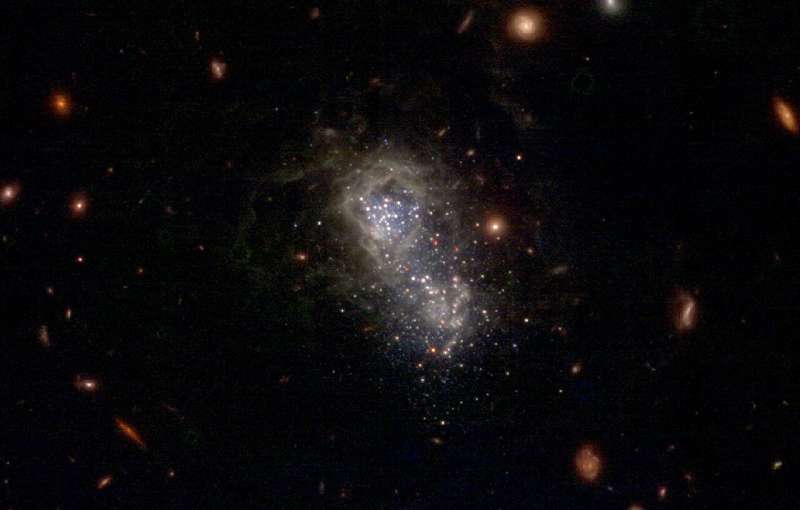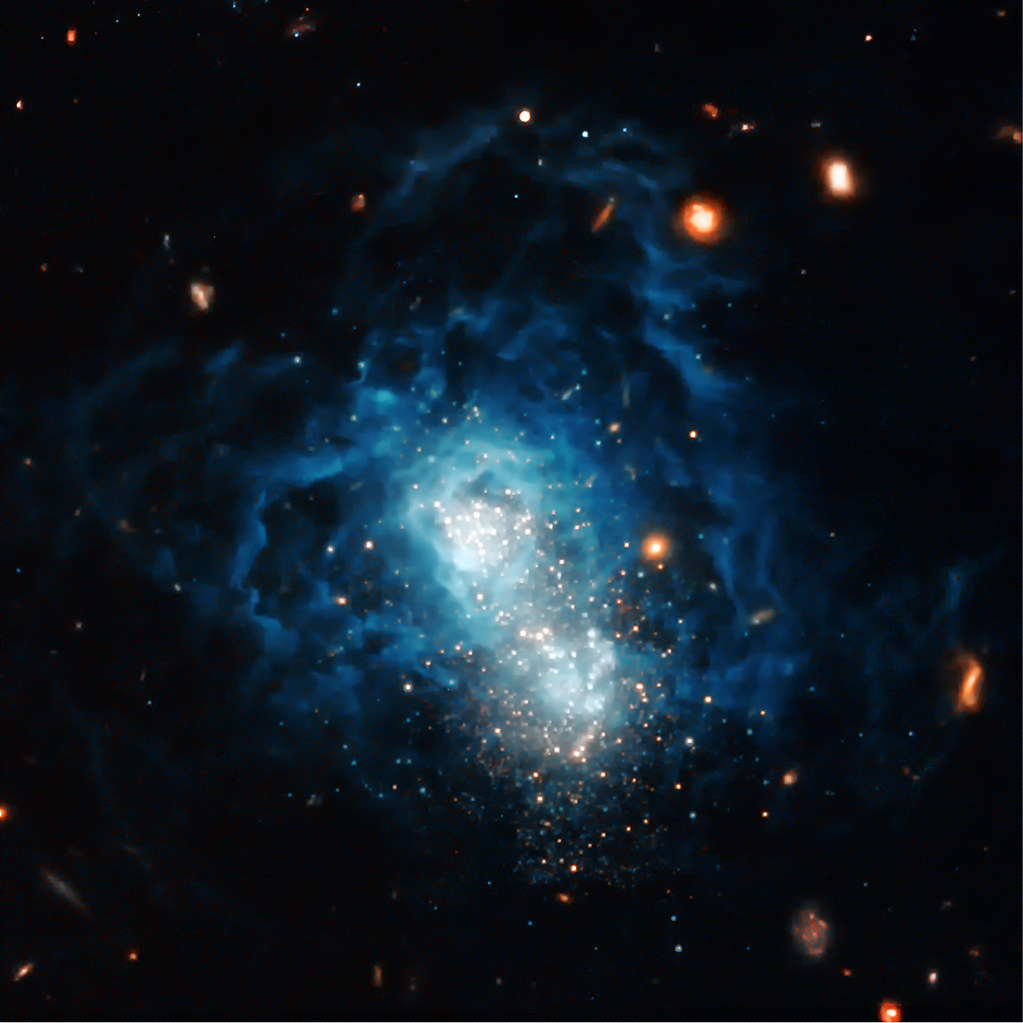Find out the latest thinking about our universe.
-
AVAO
- Commander
- Posts: 526
- Joined: Tue May 28, 2019 12:24 pm
- AKA: multiwavelength traveller
- Location: Zurich, Switzerland
Post
by AVAO » Fri Mar 22, 2024 6:38 am
Astronomers explore stellar populations of an extremely metal-poor dwarf galaxy
phys.org | 2024 March 21
Using the James Webb Space Telescope, astronomers have conducted near- and mid-infrared observations of an extremely metal-poor blue compact dwarf galaxy known as I Zwicky 18. [...] They employed JWST's Near Infrared Camera (NIRCam) and Mid-Infrared Instrument (MIRI) to investigate the stellar content of this galaxy. The observations conducted by Hirschauer's team identified extreme populations of bright, recently formed massive stars in I Zwicky 18, located predominantly among the galaxy's two central lobes of star formation—the northwest (NW) and southeast (SE) components. The obtained images also show large supershells of dust and ionized gas carved out by previous star formation and supernovae activity.
[...]
more
TY4YA Jac
-
Ann
- 4725 Å
- Posts: 13433
- Joined: Sat May 29, 2010 5:33 am
Post
by Ann » Fri Mar 22, 2024 7:54 am
AVAO wrote: ↑Fri Mar 22, 2024 6:38 am
Astronomers explore stellar populations of an extremely metal-poor dwarf galaxy
phys.org | 2024 March 21
Using the James Webb Space Telescope, astronomers have conducted near- and mid-infrared observations of an extremely metal-poor blue compact dwarf galaxy known as I Zwicky 18. [...] They employed JWST's Near Infrared Camera (NIRCam) and Mid-Infrared Instrument (MIRI) to investigate the stellar content of this galaxy. The observations conducted by Hirschauer's team identified extreme populations of bright, recently formed massive stars in I Zwicky 18, located predominantly among the galaxy's two central lobes of star formation—the northwest (NW) and southeast (SE) components. The obtained images also show large supershells of dust and ionized gas carved out by previous star formation and supernovae activity.
[...]
more
TY4YA Jac
PHYS.ORG wrote:
Blue compact dwarfs (BCDs) are low-luminosity and low-metal content dwarf galaxies experiencing violent bursts of star formation. They are characterized by a compact optical appearance and H II-region-like spectra due to highly concentrated starburst activities.
I Zwicky 18 is the archetypal BCD located about 59 million light years away in the constellation Ursa Major. This BCD is one of the most extremely metal-poor galaxies known as it is almost exclusively composed of hydrogen and helium.
Previous observations have found that I Zwicky 18 is currently experiencing a period of intensely elevated star-formation rate (SFR) and may be still creating Population III stars—hypothetical extremely massive stars, poor in elements heavier than helium, believed to have been formed in the early universe. Hence, this galaxy is perceived as an ideal laboratory to study both the young and evolved star demographics in an environment analogous to that found shortly after the Big Bang.
Alec S. Hirschauer et al. wrote:
These JWST data provide a comprehensive infrared (IR) view of I Zw 18 with eight filters utilizing both NIRCam (F115W, F200W, F356W, and F444W) and MIRI (F770W, F1000W, F1500W, and F1800W) photometry, which we have used to identify key stellar populations that are bright in the near- and mid-IR. These data allow for a better understanding of the origins of
dust and dust-production mechanisms in metal-poor environments by characterizing the population of
massive, evolved stars in the red supergiant (RSG) and asymptotic giant branch (AGB) phases.
Right... so... they use James Webb to study the most extreme blue compact dwarf galaxy that may contain never-before-seen extremely metal-poor Population III stars to find out more about the dust production in I Zwicky 18 and take a closer look at the red giants of this galaxy?
Ann
Color Commentator
-
AVAO
- Commander
- Posts: 526
- Joined: Tue May 28, 2019 12:24 pm
- AKA: multiwavelength traveller
- Location: Zurich, Switzerland
Post
by AVAO » Sat Mar 23, 2024 7:46 am
Ann wrote: ↑Fri Mar 22, 2024 7:54 am
AVAO wrote: ↑Fri Mar 22, 2024 6:38 am
Astronomers explore stellar populations of an extremely metal-poor dwarf galaxy
phys.org | 2024 March 21
Using the James Webb Space Telescope, astronomers have conducted near- and mid-infrared observations of an extremely metal-poor blue compact dwarf galaxy known as I Zwicky 18. [...] They employed JWST's Near Infrared Camera (NIRCam) and Mid-Infrared Instrument (MIRI) to investigate the stellar content of this galaxy. The observations conducted by Hirschauer's team identified extreme populations of bright, recently formed massive stars in I Zwicky 18, located predominantly among the galaxy's two central lobes of star formation—the northwest (NW) and southeast (SE) components. The obtained images also show large supershells of dust and ionized gas carved out by previous star formation and supernovae activity.
[...]
more
TY4YA Jac
PHYS.ORG wrote:
Blue compact dwarfs (BCDs) are low-luminosity and low-metal content dwarf galaxies experiencing violent bursts of star formation. They are characterized by a compact optical appearance and H II-region-like spectra due to highly concentrated starburst activities.
I Zwicky 18 is the archetypal BCD located about 59 million light years away in the constellation Ursa Major. This BCD is one of the most extremely metal-poor galaxies known as it is almost exclusively composed of hydrogen and helium.
Previous observations have found that I Zwicky 18 is currently experiencing a period of intensely elevated star-formation rate (SFR) and may be still creating Population III stars—hypothetical extremely massive stars, poor in elements heavier than helium, believed to have been formed in the early universe. Hence, this galaxy is perceived as an ideal laboratory to study both the young and evolved star demographics in an environment analogous to that found shortly after the Big Bang.
Alec S. Hirschauer et al. wrote:
These JWST data provide a comprehensive infrared (IR) view of I Zw 18 with eight filters utilizing both NIRCam (F115W, F200W, F356W, and F444W) and MIRI (F770W, F1000W, F1500W, and F1800W) photometry, which we have used to identify key stellar populations that are bright in the near- and mid-IR. These data allow for a better understanding of the origins of
dust and dust-production mechanisms in metal-poor environments by characterizing the population of
massive, evolved stars in the red supergiant (RSG) and asymptotic giant branch (AGB) phases.
Right... so... they use James Webb to study the most extreme blue compact dwarf galaxy that may contain never-before-seen extremely metal-poor Population III stars to find out more about the dust production in I Zwicky 18 and take a closer look at the red giants of this galaxy?
Ann
ThanX Ann
Exactly. I think it's just important to understand that this dwarf galaxy in its birth stage is really very close and very small, and therefore is not comparable to fully grown galaxies like our milky way galaxy.
Jac
WEBBLE (HST/JWST[F115W]) original data: NASA/ESA/CSA jac berne (flickr)
-
hijackgamy
- Asternaut
- Posts: 1
- Joined: Wed Dec 13, 2023 9:38 am
Post
by hijackgamy » Thu Mar 28, 2024 1:59 am
AVAO wrote: ↑Sat Mar 23, 2024 7:46 am
Ann wrote: ↑Fri Mar 22, 2024 7:54 am
AVAO wrote: ↑Fri Mar 22, 2024 6:38 am
Astronomers explore stellar populations of an extremely metal-poor dwarf galaxy
phys.org | 2024 March 21
TY4YA Jac
PHYS.ORG wrote:
Blue compact dwarfs (BCDs) are low-luminosity and low-metal content dwarf galaxies experiencing violent bursts of star formation. They are characterized by a compact optical appearance and H II-region-like spectra due to highly concentrated starburst activities.
I Zwicky 18 is the archetypal BCD located about 59 million light years away in the constellation Ursa Major. This BCD is one of the most extremely metal-poor galaxies known as it is almost exclusively composed of hydrogen and helium.
Previous observations have found that I Zwicky 18 is currently experiencing a period of intensely elevated star-formation rate (SFR) and may be still creating Population III stars—hypothetical extremely massive stars, poor in elements heavier than helium, believed to have been formed in the early universe. Hence, this galaxy is perceived as an ideal laboratory to study both the young and evolved star demographics in an environment analogous to that found shortly after the Big Bang.
Alec S. Hirschauer et al. wrote:
These JWST data provide a comprehensive infrared (IR) view of I Zw 18 with eight filters utilizing both NIRCam (F115W, F200W, F356W, and F444W) and MIRI (F770W, F1000W, F1500W, and F1800W) photometry, which we have used to identify key stellar populations that are bright in the near- and mid-IR. These data allow for a better understanding of the origins of
dust and dust-production mechanisms in metal-poor environments by characterizing the population of
massive, evolved stars in the red supergiant (RSG) and asymptotic giant branch (AGB) phases.
Right... so.
run 3.. they use James Webb to study the most extreme blue compact dwarf galaxy that may contain never-before-seen extremely metal-poor Population III stars to find out more about the dust production in I Zwicky 18 and take a closer look at the red giants of this galaxy?
Ann
ThanX Ann
Exactly. I think it's just important to understand that this dwarf galaxy in its birth stage is really very close and very small, and therefore is not comparable to fully grown galaxies like our milky way galaxy.
Jac
WEBBLE (HST/JWST[F115W]) original data: NASA/ESA/CSA jac berne (flickr)
I agree with your point of view. This is really meaningful when observed on special days.

